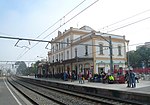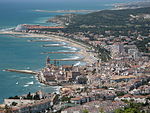Autódromo de Sitges-Terramar
Buildings and structures in the Province of BarcelonaDefunct motorsport venues in SpainMotorsport venues in CataloniaPre-World Championship Grand Prix circuitsSitges ... and 2 more
Spanish Grand PrixSport in the Province of Barcelona

The Autòdrom de Sitges-Terramar is a former racing circuit located in the small village of Rocamar, in Sant Pere de Ribes near Sitges in Barcelona, Catalonia, Spain. It was built in 1923 within 300 days, and was one of the first racetracks in the world. At the time, Europe had only two racetracks, Brooklands and Monza, and the United States only had Indianapolis. Although minor races were sporadically held on the circuit through the 1950s, it was largely abandoned after the inaugural season of 1923. Now, it has seen use only as the backdrop to a selection of car advertisements, an outing of The Grand Tour, and as a chicken farm.
Excerpt from the Wikipedia article Autódromo de Sitges-Terramar (License: CC BY-SA 3.0, Authors, Images).Autódromo de Sitges-Terramar
Antic camí de l'Autòdrom,
Geographical coordinates (GPS) Address External links Nearby Places Show on map
Geographical coordinates (GPS)
| Latitude | Longitude |
|---|---|
| N 41.238333333333 ° | E 1.7805555555556 ° |
Address
Autòdrom de Terramar
Antic camí de l'Autòdrom
08810
Catalonia, Spain
Open on Google Maps






